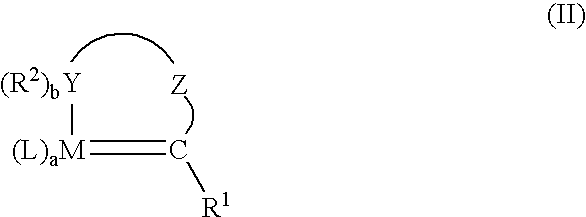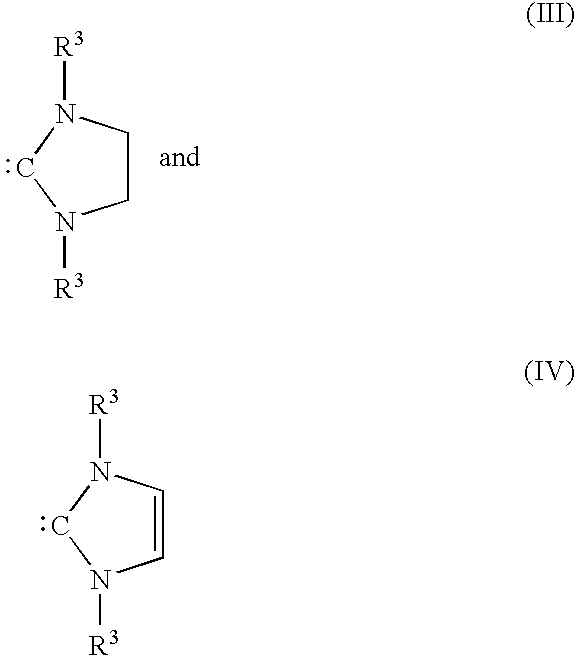Membrane Separation Of A Metathesis Reaction Mixture
a metathesis catalyst and reaction mixture technology, applied in the field of membrane separation of a metathesis reaction mixture, can solve the problems of unsatisfactory isomerization of the product olefin(s), disclosure does not address the more difficult separation, and prior art does not enable a process for separating a truly homogeneous metathesis catalyst. , to achieve the effect of reducing the possibility of undesirable isomerization, reducing the chance of catalyst inhibition, and enhancing overall process
- Summary
- Abstract
- Description
- Claims
- Application Information
AI Technical Summary
Benefits of technology
Problems solved by technology
Method used
Image
Examples
example 1
[0053]A disk (76 mm diameter) was cut from a sheet of nanofiltration membrane (Koch MPF-50 SelRo™ brand polyvinylidene fluoride membrane) and inserted into a clean Millipore™ solvent-resistant stirred cell set on top of a membrane support plate. The stirred cell provided 40 cm2 of effective filtering surface. The apparatus was operated on top of a magnetic stirrer, which rotated an impeller inducing flow tangential to the membrane surface. The membrane had been stored in a solution of ethanol and water (50:50 vol / vol). After assembling the stirred cell and securing its cover, the membrane disk was wetted in place with ethanol introduced through a filler cap, then blown partially clear with nitrogen to verify permeability and to remove excess ethanol. Nitrogen was passed through the cell for 30 minutes to form an inert atmosphere. Nitrogen flow was sustained throughout the filling procedure to blanket liquids in the cell.
[0054]Methyl oleate (Witco, 50 ml, 42.3 g) was transferred via ...
example 2
[0056]A disk (90-mm diameter) was cut from a sheet of STARMEM™ 240 polyimide nanofiltration membrane and placed on top of a membrane support plate inside a clean, empty high-pressure stirred cell (MET Ltd., 270 ml). The membrane had a rated cut-off of 400 Daltons and a permeability of 30 L / M2-h. The stirred cell provided 54 cm2 of effective filtering surface. The cell operated on top of a magnetic stirrer, which rotated a magnetically coupled impeller inside the cell to induce flow tangential to the membrane surface.
[0057]After assembling the stirred cell and securing the bottom cover, a reagent-grade, liquid mixture of methyl oleate (50 mol percent), 1-decene (25 mol percent), and methyl 10-undecenoate (25 mol percent) was poured into the open top of the cell. The top cover was secured; pressure hoses were connected to a nitrogen cylinder, regulator, shut-off, and relief valves. Pressure (400 psig, 2,800 kPa) was applied to obtain a flow of catalyst-free solution through the membra...
PUM
| Property | Measurement | Unit |
|---|---|---|
| molecular weight | aaaaa | aaaaa |
| molecular weight | aaaaa | aaaaa |
| molecular weight | aaaaa | aaaaa |
Abstract
Description
Claims
Application Information
 Login to View More
Login to View More - R&D
- Intellectual Property
- Life Sciences
- Materials
- Tech Scout
- Unparalleled Data Quality
- Higher Quality Content
- 60% Fewer Hallucinations
Browse by: Latest US Patents, China's latest patents, Technical Efficacy Thesaurus, Application Domain, Technology Topic, Popular Technical Reports.
© 2025 PatSnap. All rights reserved.Legal|Privacy policy|Modern Slavery Act Transparency Statement|Sitemap|About US| Contact US: help@patsnap.com



